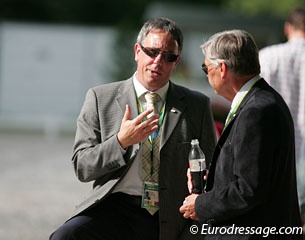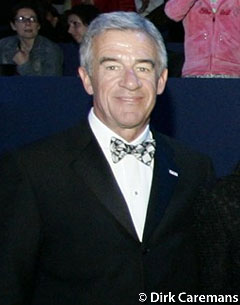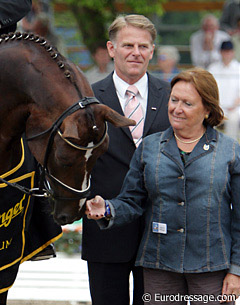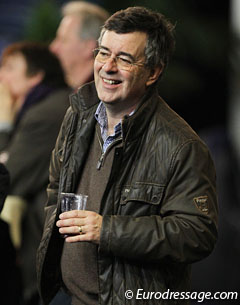
The publication of our editorial "Half Way There" about the use of half marks based on the scoring at the 2011 CDI-W Neumunster sparked quite some reaction from the FEI and several judges.
Two months after the instalment of the half-mark system, only few judges seem to have added half-marks to their scale of scores.
One week after the publication of "Half Way There" the use of half marks increased slightly at the 2011 CDI-W Gothenburg and it was noticeable that certain judges make a bigger effort at using them than others. Compared to his colleagues especially Dutch O-judge Wim Ernes stood out with his frequent use of half marks.
The band of judges seems to be divided into different camps: those in favour of half-marks (they are now actively using them) and those who struggle to see the benefits of the new system and refrain from applying them. However there also seems to be a grey area filled with judges who are willing to experiment with the half mark system through trial and error or who play the waiting game before fully coming to terms with the change. One also has to keep in mind that the reluctance to switch to the half-point system could also be because it is much harder to keep a running score in one's head if one has to use half-points as well. So no more calculating scores...
Eurodressage interviewed a few dressage officials on their opinion of the half-mark system and explored what the future might hold.
In response to "Half Way There" FEI Dressage Director Trond Asmyr issued the following statement:
"The possibility of using half marks in the judging was introduced on 1 January this year. The intention is to give judges an additional tool to allow them be even more accurate in their judging," Asmyr explained. "From time to time all judges have the view that a movement is “better than a six, but not quite a seven”. Now they have the possibility to give 6.5 in these circumstances, and hence be more accurate. A further effect is that the rider will get more accurate feedback as to what the movement is really worth. Of course it will take some time for all the judges to get used to using this system. Human beings are, by nature, all different when it comes to how fast we adapt to change. It is therefore only natural that we will see a similar development in this case."
 Asmyr stressed that the half marks are "meant to be used as an additional tool to what the judges have had in the past. The FEI will not push the judges into using half marks, and the judges will not be evaluated based on this, as might be understood from the article. We are fully confident that over time the judges will use this system to its full potential, and in those cases where it is correct to do so."
Asmyr stressed that the half marks are "meant to be used as an additional tool to what the judges have had in the past. The FEI will not push the judges into using half marks, and the judges will not be evaluated based on this, as might be understood from the article. We are fully confident that over time the judges will use this system to its full potential, and in those cases where it is correct to do so."
American O-judge Gary Rockwell, who gave zero half marks at the CDI-W Neumunster, also reacted to the editorial.
"The possibility to use half-marks has been in place for about 7 weeks, so many judges have not even had a chance to practice with them," he explained. "Most judge more national shows than international ones and until now nations have not changed their systems. In Neumunster, in fact, there were national and international classes, so I don't believe anyone is FULLY accustomed to thinking in half points - using them in perhaps two classes out of three or one horse show out of four."
Rockwell stressed, however, that judges are "accustomed to making a decision." In case of uncertainty between two whole marks, Rockwell will use the half mark. "When a shoulder-in at first appears in its positioning to be between a "6" and a "7", consideration of the quality of the gait plus all the factors of the training scale and the direction of the Handbook guides us to a decision," he said. "If I remain absolutely split between the two scores and can find no other deciding factor, I give a half-point."
 Rockwell finished his argument by pointing out that few national show organizers are not yet logistically adapted to the new system, preventing the judges from putting the half-mark system to use. "One early CDI management was unaware of the change themselves, so the scribes were in disbelief and the computers did not allow half-points to be entered. We could use them on the test sheets, but so many changes from the electronic scoreboard may have confused the riders and spectators," he explained.
Rockwell finished his argument by pointing out that few national show organizers are not yet logistically adapted to the new system, preventing the judges from putting the half-mark system to use. "One early CDI management was unaware of the change themselves, so the scribes were in disbelief and the computers did not allow half-points to be entered. We could use them on the test sheets, but so many changes from the electronic scoreboard may have confused the riders and spectators," he explained.
Rockwell believes that whole marks will continue to be used more than half marks. "It will take some time to fully develop this methodology and implement it consistently, and I'm certain that in the end, full marks will remain in the majority. Of course, our primary concern is the horse in front of us TODAY, and to use our best judgement in making an evaluation."
O-judge and former FEI Dressage Committee chair Mariette Withages referred to a five-star judges seminar held in Warendorf at the end of January 2011, where the use of half-marks was thoroughly discussed.
"Of course there were proponents and detractors of the system," Withages told Eurodressage. "Everything has its pro's and con's but half marks should only be used in case of doubt between two scores. Like one used to say in the past: 'a big six and a small 7' would now be a 6.5. Statistics have proven that less experienced judges use the half-mark system more eagerly. The more experienced judges don't need the 0.5."
 Withages believes that the new half-mark system is less advantageous for the riders. "I have nothing against the half marks and I will use them when I see fit, but I think it's a pity that we have moved away from the old system which was an advantage to the rider. This means that in case of doubt between two scores one should go for the highest mark. So when one doubts between a 6 and a 7 it used to be a 7 and now it is only a 6.5. Another disadvantage is the fact that there are clear criteria about each movement (e.g. Dressage Handbook). These are ranked from 10 to 0. During judging courses we have clarify very clearly what a 4 and a 5 is, what an 8 and a 9 is and which criteria one has to fulfil. How are they going to describe a 4.5 or an 8.5?"
Withages believes that the new half-mark system is less advantageous for the riders. "I have nothing against the half marks and I will use them when I see fit, but I think it's a pity that we have moved away from the old system which was an advantage to the rider. This means that in case of doubt between two scores one should go for the highest mark. So when one doubts between a 6 and a 7 it used to be a 7 and now it is only a 6.5. Another disadvantage is the fact that there are clear criteria about each movement (e.g. Dressage Handbook). These are ranked from 10 to 0. During judging courses we have clarify very clearly what a 4 and a 5 is, what an 8 and a 9 is and which criteria one has to fulfil. How are they going to describe a 4.5 or an 8.5?"
To Withages the new half-mark system is a step backwards instead of forwards in the development of a more accurate and correct judging system. "In the late 1950s, early 1960s they were judging with half marks. Then Colonel Gustav Nyblaeus (SWE) came as new chair of the FEI Dressage Committee and he abolished the half-mark system because he thought that judges should speak a clear language. We're back to start, just like on the goose game board."
Wayne Channon, secretary-general of the International Dressage Riders Club and major advocate of the half-mark system, shared the following with Eurodressage. "We need to call a spade a spade," he stated. "The use of half marks is about increasing accuracy. It removes the rounding up and down and that makes it more accurate. I don't buy the "we reach for the higher mark." Judging psychology is not about taking risks and it should not be. It shoud be about giving the correct mark only! Gary Rockwell is absolutely right, judges have to get in the mind-set of thinking they have an additional tool and then get into the habit of using it. It will be really hard! The more experienced a judge is with full marks, the harder it will be. I don't think we should be criticising any judge for not using them. It takes time."
David Stickland, a mathematical analyst who has been hired by the FEI to make scientifically controlled statistics of scoring patterns, confirmed to Eurodressage that there is no real analysis on the half-mark system available at this time except for those of the expirement carried out at the Judging System Trials in Aachen in September 2009.
"These are very early days for half-points so surely everyone is feeling their way around the possibilities," Stickland told Eurodressage. "Clearly any statistical analysis will require a year or so of results to be meaningful, I have seen anecdotal analyses of one or two events that of course cannot prove or disprove anything. In a normal year there are about 3,500 CDI starts, if judges used half points in even 10% of them then with a whole year's data we would start to be able to see differences between judges at the 15-20% level. Until we have that much data there is nothing meaningful that statistics can add to this discussion. Clearly some judges are more comfortable and some judges are less comfortable with using half-points. There is absolutely no statistically meaningful evidence that more experienced judges do not need them and less experienced ones do, there could be no such evidence at this time. In fact as I understood the goal was to discover if judges can do better if they have access to such changes in the system."
 Stickland emphasized that it takes time for judges to get adapted to a new system. "My impression was that the Dressage Task Force, and then the Dressage Committee, proposed using them so that all judges could be more precise in the note they wanted to give," said David. "Clearly there will be a learning curve as judges come to understand where it can be useful and where they prefer to stick to whole numbers."
Stickland emphasized that it takes time for judges to get adapted to a new system. "My impression was that the Dressage Task Force, and then the Dressage Committee, proposed using them so that all judges could be more precise in the note they wanted to give," said David. "Clearly there will be a learning curve as judges come to understand where it can be useful and where they prefer to stick to whole numbers."
The use of half-marks will enable judges to more precise and accurate in their assessment of each test. "As long as judges are willing to use words like: "big 6", "small 8", etc, then that means they could give a more precise score for this figure than the whole numbers allow, and that is exactly what they have been given the opportunity to do," Stickland explained. "Many judges in the past have carried over terms like "big 7" and then pushed up or down a later note on the same type of figure. Some senior O-judges teach that technique in their training seminars. They were using half-points anyway, but now they can do it without that carry-over from figure to figure which should allow them to get closer to the ideal of judging each figure on its own merits."
Stickland referred back to the major analyses he carried out for the FEI proving that the old judging system is at the end of its capacity. "I have shown at the Global Dressage Forum this year that most judges are judging at about the limits of the current system," David explained. "If they want to do better then we have to try expanding that system in some way and this looks a promising possibility."
by Astrid Appels © Eurodressage
Related Links
Half Way There
The Judging System in the Firing Line at the 2010 Global Dressage Forum